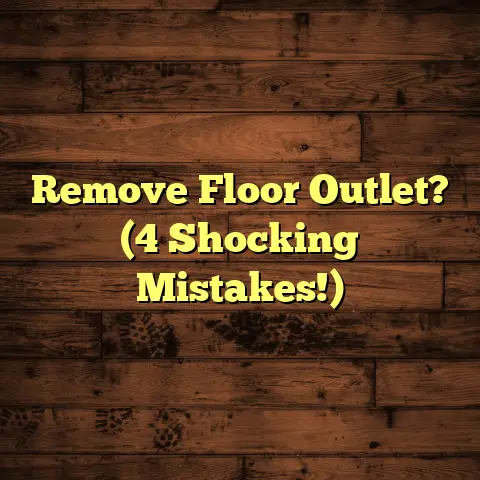Gasoline Smell on Concrete? Quick Fix! (2 Steps)
Ever walk into your garage and think, “Did I accidentally open a gas station franchise?”
That moment when you inhale and wonder if you should call a hazmat team instead of your buddy for that weekend project?
Yeah, we’ve all been there.
That pesky gasoline smell seeping into your concrete is no joke, but don’t worry, we’re about to kick it out faster than you can say “high octane”!
Section 1: Understanding the Gasoline Smell on Concrete
1.1 What Causes the Gasoline Smell?
Gasoline on concrete is like that uninvited guest who just won’t leave.
It usually happens from spills, leaks from your car (guilty!), or maybe you weren’t as careful as you thought when storing that gas can for the lawnmower.
These little “oops” moments can lead to a big, stinky problem. I remember one time, I was transferring gas from a can to my snowblower, and well, let’s just say gravity and I had a disagreement.
The concrete paid the price.
1.2 Why Concrete Holds Onto Smells
Concrete is like a super-absorbent sponge, but instead of soaking up water, it’s sucking up odors like a vacuum cleaner for smells.
Its porous nature means gasoline can penetrate deep inside, making it cling on for dear life.
Think of it as concrete having a serious attachment issue to gasoline fumes.
According to the Portland Cement Association, concrete’s porosity can range from 10-15%, which gives plenty of room for liquids to seep in. Portland Cement Association
Section 2: Step 1 – Absorb the Odor
2.1 Gather Your Supplies
Alright, time to assemble your odor-fighting arsenal.
Here’s what you’ll need:
- Cat Litter (the cheaper, the better): Yes, your cat’s throne can actually help you!
- Baking Soda: The all-purpose cleaner and odor absorber extraordinaire.
- Activated Charcoal: This stuff is like a black hole for smells.
I know, it sounds like you’re preparing for a science experiment, but trust me, these common household items are surprisingly effective.
I once used cat litter to soak up a massive oil spill in my own garage. Let’s just say my cat wasn’t thrilled I borrowed from his personal stash.
2.2 Application Technique
Here’s the step-by-step guide to odor absorption:
-
Spread it on: Generously cover the gasoline- stained area with your chosen absorbent material. Don’t be shy, really pile it on.
-
Let it Sit: This is the crucial part. Let the absorbent sit for at least 24-48 hours. The longer, the better. Think of it as a spa day for your concrete.
-
Sweep it Up: Sweep up the used absorbent material and dispose of it properly. (Don’t just dump it in your neighbor’s yard!)
I always recommend wearing gloves and a mask during this process.
You don’t want to breathe in gasoline fumes or get absorbent dust all over yourself.
Trust me, I learned that the hard way when I ended up looking like a ghost after a baking soda incident.
Section 3: Step 2 – Clean the Area
3.1 Choosing the Right Cleaner
Now that you’ve absorbed the bulk of the odor, it’s time to bring in the heavy-duty cleaners.
Here are a few options:
- Commercial Degreasers: These are specifically designed to break down grease and oil. Look for ones that are biodegradable.
- Vinegar: The natural, all-purpose cleaner. It’s not as strong as a degreaser, but it’s a good option for milder cases.
- TSP (Trisodium Phosphate): This is a powerful cleaner, but be careful! It can be harsh on surfaces and the environment. Follow the instructions carefully.
Choosing the right cleaner depends on the severity of the gasoline smell and your personal preference.
I tend to lean towards commercial degreasers because they’re specifically formulated for this type of mess.
Think of it as bringing in the professionals to finish the job.
3.2 The Cleaning Process
Alright, let’s get down to scrubbing!
-
Apply the Cleaner: Follow the instructions on your chosen cleaner and apply it to the affected area. Don’t be afraid to use a generous amount.
-
Scrub-a-Dub-Dub: Use a stiff brush to scrub the concrete surface vigorously. Really put some elbow grease into it!
-
Rinse Thoroughly: Rinse the area with plenty of water to remove all traces of the cleaner. You might need to rinse it multiple times.
-
Dry it Out: Allow the concrete to air dry completely. This might take a few hours or even a day, depending on the weather.
I always recommend wearing eye protection and gloves during the cleaning process.
You don’t want to get cleaner in your eyes or irritate your skin.
I once accidentally splashed degreaser in my face while cleaning a particularly stubborn stain.
Let’s just say it wasn’t a pleasant experience!
Section 4: The Aftermath – What to Do Next?
4.1 Assessing Your Success
So, how do you know if you’ve successfully banished the gasoline smell?
Here are a few tips:
-
The Sniff Test: Take a deep breath and see if you can still detect the gasoline odor. If you can, repeat the cleaning process.
-
The Nose Knows: Sometimes your nose can become desensitized to smells. Ask a friend or family member to take a sniff and give you their honest opinion.
-
Pet Patrol: Pets are often more sensitive to smells than humans. If your dog or cat is still avoiding the area, there’s a good chance the smell is still lingering.
If the smell persists after multiple attempts, you might need to consider calling in a professional cleaning service.
They have specialized equipment and chemicals that can tackle even the most stubborn odors.
I had a client once who tried everything to remove a gasoline smell from their garage.
In the end, they had to hire a company that used ozone generators to completely eliminate the odor.
4.2 Preventing Future Odors
Prevention is always better than cure, right?
Here are a few tips to avoid future gasoline smells:
-
Be Careful When Filling Up: Use a funnel when transferring gasoline to avoid spills. It’s a simple tool that can save you a lot of headaches.
-
Store Gasoline Properly: Store gasoline in approved containers and keep them in a well- ventilated area.
-
Check for Leaks: Regularly inspect your car and other equipment for leaks. Fix any leaks promptly to prevent gasoline from seeping into your concrete.
-
Use a Garage Mat: Consider using a garage mat to protect your concrete floor from spills and stains.
I always tell my clients that being proactive is the key to preventing future problems.
A little bit of caution can go a long way in keeping your garage smelling fresh and clean.
Conclusion
So, there you have it!
Two simple steps to banish that gasoline smell from your concrete.
It might seem like a daunting task, but with a little elbow grease and the right supplies, you can conquer that stinky odor and reclaim your garage.
Remember, dealing with gasoline smells is a lot more manageable (and funny) than it appears.
So, grab your cat litter, baking soda, and scrub brush, and get ready to tackle that concrete problem with confidence (and maybe even a laugh).
Good luck, and may your garage forever smell like sunshine and roses (or at least not gasoline)!





